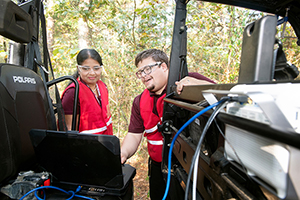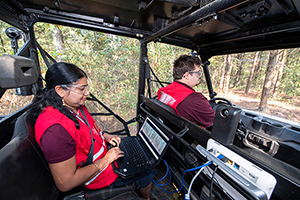High Performance Computing Collaboratory Powers CAVS-Center for Advanced Vehicular Systems Led Project that Supports the U.S. Army's ERDC Ground Mobility Research in Several Key Areas
October 11, 2019
Lalitha Dabbiru, assistant research professor at Mississippi State’s Center for Advanced Vehicular Systems, and Christopher Hudson, CAVS research engineer, examine LIDAR data collected on the Proving Ground, a new 50-acre property recently acquired to advance the center’s off-road autonomous vehicle research. The remote sensing data will be used to develop algorithms aimed at improving the performance of autonomous vehicles in off-road environments.
Photo by Beth Wynn
Photo by Beth Wynn
Led by MSU’s Center for Advanced Vehicular Systems, the project addresses areas such as remote sensing on autonomous vehicles, additive manufacturing, human performance and modeling and simulation development powered by the university’s High Performance Computing Collaboratory. The research will be among the first to utilize the Proving Ground, a 50-acre property recently acquired by CAVS to advance the center’s off-road autonomous vehicle research.
“This is a really exciting project with ERDC and a great continuation of our off-road autonomous mobility research, much of which is done in support of the Army,” said Clay Walden, CAVS executive director. “In addition, we are developing a digital twin of the Proving Ground, which will allow us to develop autonomous environmental sensing algorithms and then test them on the physical property. Autonomous vehicles are dependent upon being able to accurately sense their environment in order to execute a particular mission.”
The ground mobility research will involve collaboration among faculty from across MSU’s Bagley College of Engineering. The project’s technical focus areas for the project include tire and terrain interactions, powertrain modeling, sensor-physics and fusion, dust simulation, materials for design, and human fatigue. By creating advanced ground vehicle performance simulations and computing techniques, the research will create better assessments for manned and unmanned tactical vehicles.
The project is managed by ERDC’s Geotechnical and Structures Laboratory. Robert D. Moser, senior scientific technical manager for the ERDC lab, said the new partnership builds upon MSU and ERDC’s strong history of innovative research and development programs and will support the Army’s future battlefield mobility needs.

Christopher Hudson, research engineer at Mississippi State’s Center for Advanced Vehicular Systems, drives a Polaris Ranger equipped with high-tech remote sensing equipment on the Proving Ground, a 50-acre property being used to advance CAVS’ off-road autonomous vehicle research. Lalitha Dabbiru, CAVS assistant research professor, can analyze the data as the Ranger navigates off-road terrain. CAVS researchers are creating a digital twin of the Proving Ground, which will allow them to develop and test algorithms before testing them with autonomous vehicles on the property.
Photo by Beth Wynn
Photo by Beth Wynn
Based in Vicksburg, ERDC is the research unit of the U.S. Army Corps of Engineers and is one of the premier engineering and scientific research organizations in the world. MSU and ERDC have a long-standing research relationship and have collaborated on dozens of projects. In 2014, the two partnered to create the Institute for Systems Engineering Research, also housed in Vicksburg.
“Our relationship has grown because of our commonality with high-performance computing,” Walden said. “Because we have our High Performance Computing Center here, we have researchers that are very experienced in developing highly granular physics-based codes on our HPC system. We have students here working on ERDC-funded projects who often take the next natural step and go to work for them. ERDC is a tremendous asset for the state of Mississippi, and we’re proud to supply the next generation of these researchers.”
CAVS is an interdisciplinary research center that uses state-of-the-art technology to address engineering challenges facing U.S. mobility industries. The center broadens its impact by supporting economic development and outreach activities throughout Mississippi. For more, visit www.cavs.msstate.edu.
ERDC is a diverse research organization with approximately 2,000 employees operating more than $1 billion in world class facilities at seven laboratories. Its annual program exceeds $1 billion as it supports the Department of Defense and other agencies in military and civilian projects.
For more, visit www.erdc.usace.army.mil.
MSU is Mississippi’s leading university, available online at www.msstate.edu.
Written by James Carskadon
